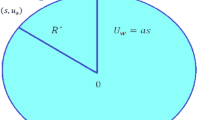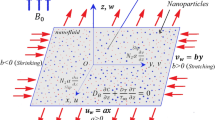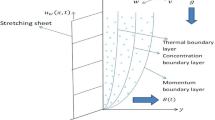Abstract
This article deals with the electromagnetohydrodynamic Casson Nanofluid flow induced by a stretching Riga plate in a non-Darcian porous medium under the influence of internal energy change, Arrhenius activation energy, chemical reaction and Melting heat transfer. The flow motion is induced as a result of the introduced mechanism that capable of controlling or assisting a weakly hydromagnetic fluid flow process called the Riga plate. In most of the literature, the thermophysical properties of the fluid are assumed to be constant. However, this present study bridges this gap by assuming that viscosity, conductivity and diffusivity are all temperature dependent. Also, the exponential decaying Grinberg term is used as a resistive force in this investigation due to the electromagnetic properties of the Riga plate in the momentum conservation equation. The resulting coupled nonlinear ordinary differential equations are solved by optimal homotopy analysis method (OHAM) and validated with Galerkin weighted residual method (GWRM). Analyses reveal that the Casson fluid exhibits a solid characteristic when yield stress is more than the shear stress. The thermal profile raised with an increase in melting and Casson parameter. Also, also the chemical reaction parameter reduces the nanoparticle volume fraction. Moreover, this article includes some future recommendations. These results will assist the engineers in designing applications that require high heat and mass transfer rates.





Similar content being viewed by others
Data Availability Statement
All the data generated and materials during this study are included in this research article. This manuscript has associated data in a data repository. [Authors’ comment: All data used in this manuscript can be obtained on request from the corresponding author.]
Abbreviations
- \(u, v\) :
-
Velocity in x and y directions
- \( D_{{B\infty }} \) :
-
Constant Brownian diffusion coefficient
- \(\mu_{\infty }\) :
-
Constant viscosity
- \(\varepsilon_{1} ,\varepsilon_{3} ,\varepsilon_{5}\) :
-
Positive constants
- \(\rho_{\infty }\) :
-
Density of the base fluid
- \(\epsilon_{2}\) :
-
Variable viscosity parameter
- \(\beta\) :
-
Casson parameter
- \(\epsilon_{4}\) :
-
Variable thermal conductivity parameter
- \(k\left( T \right)\) :
-
Variable thermal conductivity
- \(\epsilon_{6}\) :
-
Variable mass diffusivity parameter
- \(\mu \left( T \right)\) :
-
Variable viscosity
- \(T_{m} , T_{0}\) :
-
Solid surface temperature
- \(D_{B} \left( C \right)\) :
-
Variable mass diffusivity
- \(T_{\infty }\) :
-
Ambient temperature
- \(D_{T}\) :
-
Thermophoretic diffusion coefficient
- \(T\) :
-
Nanofluid temperature
- \(c_{p}\) :
-
Specific heat at constant pressure
- \(C_{w}\) :
-
Wall nanoparticle volume fraction
- \(k_{\infty }\) :
-
Constant nanofluid thermal conductivity
- \(C_{\infty }\) :
-
Ambient nanoparticle volume fraction
- \(c_{s}\) :
-
Specific heat of the solid surface
- \(a\) :
-
Positive constant
- \(J_{0}\) :
-
Current density
- \(M\) :
-
Magnetization in magnets
- \(\nu_{\infty }\) :
-
Constant kinematic viscosity
- \(s\) :
-
Width of magnets and electrodes
- \(\lambda\) :
-
Latent heat of diffusion
- \(\alpha_{\infty }\) :
-
Constant thermal diffusivity
- \(E\) and \(Kr\) :
-
Chemical reaction and activation energy
- \(C\) :
-
Nanoparticle volume fraction
- \(\left( {k_{p} } \right)_{o}\) :
-
Permeability coefficient
- Pr:
-
Prandtl number
- Nb:
-
Brownian motion parameter
- Nt:
-
Thermophoresis parameter
- Sc:
-
Schimdt number
- Me:
-
Melting parameter
- Ec:
-
Eckert number
- Z:
-
Modified Hartman number
- B:
-
Dimensionless parameter
- Pp:
-
Porosity parameter
- \( \epsilon_{2}\) :
-
Variable viscosity parameter
- \( \epsilon_{4}\) :
-
Variable thermal conductivity parameter
- \( \epsilon_{6}\) :
-
Variable mass diffusivity parameter
- \(\tau\) :
-
Ratio of nanoparticle heat capacity to the fluid heat capacity
References
G. Mutschke, G. Gerbeth, T. Albrecht, R. Grundmann, Eur. J. Mech.-B/Fluids 25(2), 137–152 (2006). https://doi.org/10.1016/j.euromechflu.2005.05.002
A.M. Obalalu, F.A. Wahaab, L.L. Adebayo, J. Taibah Univ. Sci. 14(1), 541–548 (2020). https://doi.org/10.1080/16583655.2020.1748844
R. Ellahi, S.Z. Alamri, A. Basit, A. Majeed, J. Taibah Univ. Sci. 12(4), 476–482 (2018). https://doi.org/10.1080/16583655.2018.1483795
O. Lielausis, Appl. Magnetohydrodyn. 12, 143–146 (1961)
R. Kumar, S. Sood, S.A. Shehzad, M. Sheikholeslami, J. Mol. Liq. 248, 143–152 (2017). https://doi.org/10.1016/j.molliq.2017.10.018
P. Loganathan, K. Deepa, A. Mechanics, J. Theor. 57 (2019) I https://doi.org/10.15632/jtam-pl/112421
Z. Iqbal, E. Azhar, Z. Mehmood, E. Maraj, Results Phys. 7, 3648–3658 (2017). https://doi.org/10.1016/j.rinp.2017.09.047
H. Vaidya, K. Prasad, I. Tlili, O. Makinde, C. Rajashekhar, S.U. Khan, R. Kumar, D. Mahendra, Case Studies Therm. Eng. 24, 100828 (2021). https://doi.org/10.1016/j.csite.2020.100828
Yu, W. and H. Xie, J. Nanomater. 2012 (2012) https://doi.org/10.1155/2012/435873
A.R. Sajadi, S.S. Sadati, M. Nourimotlagh, O. Pakbaz, D. Ashtiani, F. Kowsari, Therm. Sci. 18(4), 1315–1326 (2014). https://doi.org/10.2298/TSCI131114022S
K. Rafique, H. Alotaibi, T.A. Nofal, M.I. Anwar, M. Misiran, I. Khan, J. Math. 2020 (2020) https://doi.org/10.1155/2020/6617652
T. Zhang, Y. Zhang, H. Zhu, Z. Yan, Compos. Struct. 256, 112988 (2021). https://doi.org/10.1016/j.compstruct.2020.112988
I.S. Oyelakin, S. Mondal, P. Sibanda, Alex. Eng. J. 55(2), 1025–1035 (2016). https://doi.org/10.1016/j.aej.2016.03.003
A. Afsar Khan, R. Ellahi, K. Vafai, Adv. Math. Phys. 2012 (2012) https://doi.org/10.1155/2012/169642
A. Ahmad, M. Ahmad, M. Nazar, Z.U. Nisa, N.A.J.M.S. Shah, Math. Sci. 1–13 (2021)
S. Arrhenius, J. Zeitschrift für Physikalische Chemie 31 (1), 197–229 (1899) https://doi.org/10.1515/zpch-1899-3120
W. Li, J. Huang, Z. Zhang, H. Huang, J. Liang, J. Appl. Polym. Sci. 138(1), 49615 (2021). https://doi.org/10.1002/app.49615
A. Bestman, Int. J. Energy Res. 14(4), 389–396 (1990). https://doi.org/10.1002/er.4440140403
M. Ayub, T. Abbas, M. Bhatti, Eur. Phys. J. Plus 131(6), 1–9 (2016). https://doi.org/10.1140/epjp/i2016-16193-4
I.H. Qureshi, M. Nawaz, S. Rana, T. Zubair, Commun. Theor. Phys. 70(1), 049 (2018)
M.M. Rahman, M. Rahman, M. Samad, M. Alam, Int. J. Thermophys. 30(5), 1649 (2009). https://doi.org/10.1007/s10765-009-0656-5
I. Mustafa, Z. Abbas, A. Arif, T. Javed, A. Ghaffari, Physica A: Stat. Mech. Appl. 540, 123028 (2020). https://doi.org/10.1016/j.physa.2019.123028
A.M. Obalalu, I. Kazeem, A. Abdulrazaq, O.A. Ajala, A. Oluwaseyi, A.T. Adeosun, L.L. Adebayo, F.A. Wahaab, J. Serb. Soc. Comput. Mech. 14 (2), 503–519 (2020) https://doi.org/10.24874/jsscm.2020.14.02.10
R. Fazio, A. Jannelli, Math. Comput. Appl. (2021) https://doi.org/10.20944/preprints202102.0125.v1
B.S. Goud, P.P. Kumar, B.S. Malga, Part. Differ. Equ. Appl. Math. 2, 100015 (2020). https://doi.org/10.1016/j.padiff.2020.100015Get
A. Mahdy, A.J. Chamkha, H.A. Nabwey, Alex. Eng. J. 59(3), 1693–1703 (2020). https://doi.org/10.1016/j.aej.2020.04.028
O. Ajala, P. Adegbite, S. Abimbade, A. Obalalu, Int. J. Appl. Math. Stat. Sci. (2019)
O.A. Ajala, A.M. Obalalu, O.T. Akinyemi, S.F. Abimbade, Int. J. Sci. Res. Publ. 9 (6) (2019) https://doi.org/10.29322/IJSRP.9.06.2019.p9094
M.H. Abolbashari, N. Freidoonimehr, F. Nazari, M.M. Rashidi, J Adv. Powd. Technol. 26(2), 542–552 (2015). https://doi.org/10.1016/j.apt.2015.01.003
W. Khan, I. Pop, Int. J. Heat 53(11–12), 2477–2483 (2010). https://doi.org/10.1016/j.ijheatmasstransfer.2010.01.032
O.D. Makinde, A. Aziz, Int. J. Therm. Sci. 50(7), 1326–1332 (2011). https://doi.org/10.1016/j.ijthermalsci.2011.02.019
A. Wakif, A. Chamkha, I. Animasaun, M. Zaydan, H. Waqas, R. Sehaqui, Arab. J. Sci. Eng. 45(11), 9423–9438 (2020). https://doi.org/10.1007/s13369-020-04757-3
Acknowledgements
The author appreciates the excellent research facilities provided by Kwara state university.
Funding
No funding was received for conducting this study.
Author information
Authors and Affiliations
Corresponding author
Ethics declarations
Conflict of interest
No declarations by the writer.
Rights and permissions
About this article
Cite this article
Obalalu, A.M., Ajala, O.A., Akindele, A.O. et al. Effect of melting heat transfer on electromagnetohydrodynamic non-newtonian nanofluid flow over a riga plate with chemical reaction and arrhenius activation energy. Eur. Phys. J. Plus 136, 891 (2021). https://doi.org/10.1140/epjp/s13360-021-01869-z
Received:
Accepted:
Published:
DOI: https://doi.org/10.1140/epjp/s13360-021-01869-z




